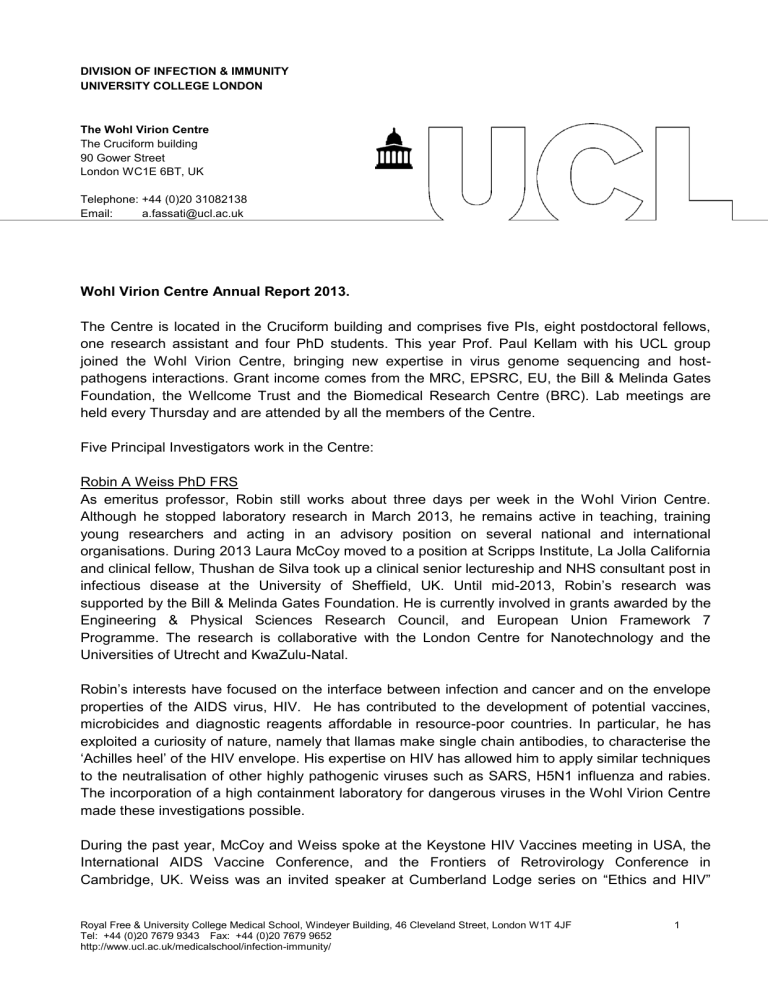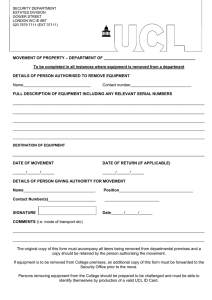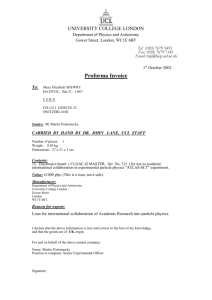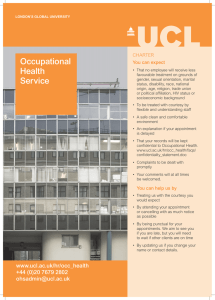DIVISION OF INFECTION & IMMUNITY UNIVERSITY COLLEGE LONDON The Wohl Virion Centre

DIVISION OF INFECTION & IMMUNITY
UNIVERSITY COLLEGE LONDON
The Wohl Virion Centre
The Cruciform building
90 Gower Street
London WC1E 6BT, UK
Telephone: +44 (0)20 31082138
Email: a.fassati@ucl.ac.uk
Wohl Virion Centre Annual Report 2013.
The Centre is located in the Cruciform building and comprises five PIs, eight postdoctoral fellows, one research assistant and four PhD students. This year Prof. Paul Kellam with his UCL group joined the Wohl Virion Centre, bringing new expertise in virus genome sequencing and hostpathogens interactions. Grant income comes from the MRC, EPSRC, EU, the Bill & Melinda Gates
Foundation, the Wellcome Trust and the Biomedical Research Centre (BRC). Lab meetings are held every Thursday and are attended by all the members of the Centre.
Five Principal Investigators work in the Centre:
Robin A Weiss PhD FRS
As emeritus professor, Robin still works about three days per week in the Wohl Virion Centre.
Although he stopped laboratory research in March 2013, he remains active in teaching, training young researchers and acting in an advisory position on several national and international organisations. During 2013 Laura McCoy moved to a position at Scripps Institute, La Jolla California and clinical fellow, Thushan de Silva took up a clinical senior lectureship and NHS consultant post in infectious disease at the University of Sheffield, UK. Until mid2013, Robin’s research was supported by the Bill & Melinda Gates Foundation. He is currently involved in grants awarded by the
Engineering & Physical Sciences Research Council, and European Union Framework 7
Programme. The research is collaborative with the London Centre for Nanotechnology and the
Universities of Utrecht and KwaZulu-Natal.
Robin’s interests have focused on the interface between infection and cancer and on the envelope properties of the AIDS virus, HIV. He has contributed to the development of potential vaccines, microbicides and diagnostic reagents affordable in resource-poor countries. In particular, he has exploited a curiosity of nature, namely that llamas make single chain antibodies, to characterise the
‘Achilles heel’ of the HIV envelope. His expertise on HIV has allowed him to apply similar techniques to the neutralisation of other highly pathogenic viruses such as SARS, H5N1 influenza and rabies.
The incorporation of a high containment laboratory for dangerous viruses in the Wohl Virion Centre made these investigations possible.
During the past year, McCoy and Weiss spoke at the Keystone HIV Vaccines meeting in USA, the
International AIDS Vaccine Conference, and the Frontiers of Retrovirology Conference in
Cambridge, UK. Weiss was an invited speaker at Cumberland Lodge series on “Ethics and HIV”
Royal Free & University College Medical School, Windeyer Building, 46 Cleveland Street, London W1T 4JF
Tel: +44 (0)20 7679 9343 Fax: +44 (0)20 7679 9652 http://www.ucl.ac.uk/medicalschool/infection-immunity/
1
and at the International Institute of Genetic Engineering & Biotechnology in New Delhi, India. An invited review article written by McCoy and Weiss entitled “Neutralizing antibodies to HIV-1 induced by immunization” was published in the Journal of Experimental Medicine in 2013. Laura McCoy won a prestigious EU Marie Curie Award commencing in 2014.
Robin Weiss has recently been appointed Chair of the Scientific Advisory Committee of the
International AIDS Vaccine Initiative, Reviews Editor of the learned journal, Retrovirology , and a member of the Nuffield Council for Bioethics. In 2013, Robin received a rare accolade for a British scientist of being elected a Foreign Associate of the US National Academy of Sciences.
Clare Jolly PhD
Clare Jolly is an MRC Career Development Fellow who joined the Wohl Virion Centre in 2009. Her lab comprises two postdoctoral fellows, Dr Elisabetta Groppelli and Dr Alice Len and a MRC funded
PhD student, Shimona Starling. Her work is funded by a MRC Career Development Award and a
MRC project grant. The research interests of the Jolly laboratory are directed at understanding the molecular mechanisms that regulate Human Immunodeficiency Virus transmission between CD4+ T cells – the main targets for the virus in vivo . This mode of HIV-1 transmission is important because it escapes most antiretroviral drugs developed so far and may be one of the main mechanisms to allow virus spread in lymphoid organs and during reactivation from latency. Clare’s laboratory has recently shown that different classes of antiretroviral drugs vary in their ability to inhibit cell-cell spread of HIV. Specifically, they found that protease inhibitors effectively blocked cell-cell spread whereas reverse transcriptase inhibitors were less effective. This work was published in the journal
Retrovirology . In addition in collaboration with Robin Weiss’s laboratory she has been evaluating antibody-mediated inhibition of cell-cell spread and this work is being prepared for submission.
Clare’s group is especially interested in how the virus hijacks and possibly modifies existing cellular machinery to promote efficient transmission by direct cell-to-cell spread. Such host factors may represent novel targets for therapeutic development. She has recently shown that HIV infected T cells can respond to contact with an uninfected T cell by polarizing the cellular cytoskeleton and secretory organelles towards the contact site. This work was published in 2011 in the open access journal PloS Pathogens and additional publications are being prepared for submission. Dr Jolly has recently given invited seminars at the Institut Cochin in Paris, King’s College London, Imperial
College London and as part of the Bloomsbury Research Institute, a new joint-initiative between
UCL and the London School of Hygiene and Tropical Medicine. She was an invited speaker at the
2012 Keystone Symposia meeting on Frontiers in HIV Pathogenesis, Therapy and Eradication in
Canada and co-organised the annual UK Recently Independent Virology Researchers (RIVR) in
2013 and 2014.
Yasuhiro Takeuchi PhD
Yasu Takeuchi’s group currently comprises a research associate (Ilaria Nisoli started in December
2013 on a new EU FP7 programme); three PhD students (Sabine Winkler (mainly based at the
NIBSC), Khaled Samber (his primary supervisor is Mary Collins) and Kanayo Doi (started in June
2012, awarded a highly-competitive full-studentship from Japan Student Services Organization)); a full-time master project student from University of Milan (Marta Ferraresso) . Yasu’s main interests are in gene therapy and in xenotransplantation.
Yasu’s work in gene therapy is in collaboration with Mary Collins in two directions. A project taken on by Khaled and Marta is the development of stable LV packaging cell lines for future clinical
Royal Free & University College Medical School, Windeyer Building, 46 Cleveland Street, London W1T 4JF
Tel: +44 (0)20 7679 9343 Fax: +44 (0)20 7679 9652 http://www.ucl.ac.uk/medicalschool/infection-immunity/
2
application. This development has extended to vector processing following harvest from producer cells in collaboration with Sabine/NIBSC whose main project is proteomics of vector preparations.
Kanayo takes on continuation of our effort in the study of insertional mutagenesis by lentiviral vectors with particular interest in mutagenesis caused by aberrant splicing between a cellular gene and the vector genome.
Takeuchi is a leader in the field of safety in xenotransplantation and he studies the risks associated with potential zoonosis following transplantation of pig organs. Various studies funded by EU FP6
XENOME consortium in which Takeuchi acted as the work package leader on safety (funding duration ended in April 2012) continued to be published (Ref 1-4). One of these (Ref 2), which
Yasu corresponded, reported induction of xeno-antibodies against sugars with terminal sialic acid of non-human type Neu5Gc in burn patients treated with vital pigskin. This work inspired him and his
European collaborators to form a new EU consortium TRANSLINK under FP7 to define the role of xeno-directed and autoimmune events in patients receiving animal-derived bioprosthetic heart valves. Ilaria started to work on this project recently. With regards of xenotransplantation safety,
Yasu will be involved as a subcontractor to Glasgow Caledonian University (Linda Scobie) in another newly formed FP7 consortium XENOISLET which seeks development towards clinical trials of pig islet cell transplantation for diabetes.
Ariberto Fassati MD PhD
Ari Fassati is the Director of the Wohl Virion Centre. His group comprises an MRC funded postdoctoral fellow, Alex Zhyvoloup, an EU FP7 Innovative Medicine-funded postdoctoral fellow,
Aksana Labokha, one undergraduate student (Nicole Yim), and Nan-Yu Chen, a paediatrician with expertise in infectious diseases who won a Governmental scholarship from Taiwan and joined the
Wohl Virion Centre as a PhD student in 2011. Ari also co-supervises two PhD students mainly based at the London Centre for Nanotechnology: Dino Osmanovic (soon to submit his thesis) and
Aizhan Bestembayeva. He collaborates with Bart Hoogenboom (London Centre for
Nanotechnology), Stephan Beck (UCL Cancer Institute), Liz Murchison and Michael Stratton
(Wellcome Trust Sanger Institute), Peter Cherepanov (CRUK), Ben Berkhout (AMC Amsterdam),
Alessandro Marcello (ICGEB Trieste).
The Fassati lab has three main interests: the discovery of new antiviral drug targets, understanding the mechanisms of viral nuclear transport, and understanding the origin and mechanisms of regression of the canine transmissible venereal tumour (CTVT) as a model to understand cancer regression in general.
In 2010 Fassati, with MRC funding, set up a high through put cell based screening facility in the
Wohl Virion Centre to perform screenings with live pathogens. In 2012 the first two screening projects were completed and the group made several discoveries; First, Hsp90 is required for HIV-1 gene expression and reactivation during hyperthermia (PLoS Path. 2012). Second, a transcription factor that induces histone acetylation important for HIV-1 gene expression has been identified by chemical genetics. A compound that inhibits the transcription factor has been identified (manuscript in preparation). Third, in collaboration with Robin Weiss and Laura McCoy, a high through put screening was performed and two new llama nanobodies with very broad and potent HIV-1 neutralizing activity have been isolated. Importantly, such nanobodies appear to target the CD4 receptor using the same "angle of approach" of the very broad human neutralizing antibodies recently identified (VCR01, VCR02). A patent has been filed on these new nanobodies and a paper submitted.
Royal Free & University College Medical School, Windeyer Building, 46 Cleveland Street, London W1T 4JF
Tel: +44 (0)20 7679 9343 Fax: +44 (0)20 7679 9652 http://www.ucl.ac.uk/medicalschool/infection-immunity/
3
In collaboration with Bart Hoogenboom, Fassati is elucidating the biophysical nature of the selective barrier present in nuclear pores using biochemical methods, atomic force microscopy and mathematical modelling. The first paper describing the model was recently published (Phys Rev E
2012) and another experimental paper is currently under review. In addition, with Peter Cherapanov,
Ari has contributed the crystal structure of the nuclear transport receptor Transportin 3 and identified critical functional domains for the transport of splicing factors and for HIV-1 infection
(PNAS 2014).
In collaboration with Stephan Beck, Liz Murchison and Mike Stratton, the Fassati lab has identified approximately 300 genes that are differentially expressed in progressive or regressive CTVT and mapped epigenetic changes of such genes, which will help to understand the mechanisms leading to its regression (ongoing work). Weiss and Fassati collaborated with the Sanger Centre to elucidate the origins of CTVT (Science 2014).
Ari co-organised the 2013 international meeting “Frontiers of Retrovirology” in Cambridge, which was a significant success http://www.frontiers-of-retrovirology.com/. He was invited speaker at the 6 th Nuclear Envelope and Chromatin Organisation” meeting, and at NIMR Mill
Hill, London. Ari also joined the CSS2 Basic Science Board of the ANRS (Agence Nationale de
Recherche sur le Sida et les hépatites).
Paul Kellam PhD
Paul Kellam is the Viral Genomics group leader and Senior Investigator at the Wellcome Trust
Sanger Institute and a Professor of Viral Pathogenesis in the Wohl Virion Centre at UCL.
Paul’s research uses virus and host genetics to understand virus tranmission and disease pathogenesis. Although virus genomes are small they are incredibly diverse and subject to rapid genetic change. This both affords virus adaptation and evolution to but also allows the genetic tracking of viruses as the spread from person to person. Paul’s lab used such virus molecular epidemiology to understand more about the emergence of a new human virus, the
Middle East Respiratory Syndrome Coronavirus (MERS CoV). In June 2012 MERS CoV caused the first document human fatal case in a man in Saudi Arabia. MERS CoV has since caused over 180 infections with 43% of cases being fatal, mainly in Saudi Arabia. Together with Professor Ali Zumla, the Professor of Infectious Diseases and International Health at UCL and the Professor Ziad Memish of the Saudi Arabian Ministry of H ealth, Paul’s lab showed
MERS CoV most likely evolved and diversified in animals and then infected humans, probably on more than one occasion, at which point its was able to spread in a limited way from person to person. This work continues as the MERS CoV infection still occurs in the Middle East.
Paul’s lab also continues to investigate virus genome variation during influenza virus infection and how virus diversity within HIV infected patients can predict effective antiviral therapy. The emergence of MERS CoV and pandemic influenza A H1N1/09 virus over the last 4 years shows how little we know about virus diversity and the potential for viruses to jump between animal and humans, so called zoonosis. Therefore, in collaboration with groups in Cambridge and Amsterdam, Paul ’s lab has used powerful next generation sequencing methods to detect viruses in human and bat samples. Through the Wellcome Trust and Department of Health funded project ICONIC, awarded to UCL, the Sanger Institute and Public Health England,
Paul ’s lab and UCLH virology, will over the next 3 years translate some of these genome scale
Royal Free & University College Medical School, Windeyer Building, 46 Cleveland Street, London W1T 4JF
Tel: +44 (0)20 7679 9343 Fax: +44 (0)20 7679 9652 http://www.ucl.ac.uk/medicalschool/infection-immunity/
4
methods into clinical virology in the NHS, aiming to sequence and interpret the genomes from
20 000 virus isolates from routine diagnostics.
Paul’s lab has continued its work on the human gene Interferon Inducible Transmembrane 3
(IFITM3) which he identified as the first human influenza disease severity determining allele. In collaboration with Oxford University and the Beijing You’an Hospital, we showed that the
IFITM3 disease severity genotype was associated with severe influenza in China. We investigated the function of IFITM3 amino acids in preventing influenza and dengue virus infection of cells, showed in a mouse model that IFITM3 seems to only effect the pathogenesis of viruses that enter cells by acidic endosomes and that IFITM antiviral proteins are present and functional in avian species suggesting they maybe important for controlling virus zoonosis.
Paul’s lab is now continuing to drive the use of virus and host genetic studies in understand the pathogenesis of virus disease and is helping shape the collaborative studies required to do this.
Paper authored by members of the Wohl Virion Centre.
McCoy LE, Weiss RA . Neutralizing antibodies to HIV-1 induced by immunization . J Exp Med .
2013, 210:209-23. doi: 10.1084/jem.20121827.
Lutje Hulsik D, Liu YY, Strokappe NM, Battella S, El Khattabi M, McCoy LE , Sabin C, Hinz A,
Hock M, Macheboeuf P, Bonvin AM, Langedijk JP, Davis D , Forsman Quigley A, Aasa-
Chapman MM , Seaman MS, Ramos A, Poignard P, Favier A, Simorre JP, Weiss RA , Verrips
CT, Weissenhorn W, Rutten L. A gp41 MPER-specific llama VHH requires a hydrophobic
CDR3 for neutralization but not for antigen recognition . PLoS Pathogens 2013, 3:e1003202. doi: 10.1371/journal.ppat.1003202 .
Weiss RA , Stoye JP. Our viral inheritance. Science 2013, 340:820-821. doi:
10.1126/science.1235148.
Weiss RA . On the concept and elucidation of endogenous retroviruses. Philos Trans R Soc
Lond B 2013, 368:20120494. doi: 10.1098/rstb.2012.0494.
Watkins JD, Sholukh AM, Mukhtar MM, Siddappa NB, Lakhashe SK, Kim M, Reinherz EL,
Gupta S, Forthal DN, Sattentau QJ, Villinger F, Corti D, Ruprecht RM, CAVD Project Group .
Anti-HIV IgA isotypes: differential virion capture and inhibition of transcytosis are linked to prevention of mucosal R5 SHIV transmission.
AIDS . 2013, 27:F13-20. doi:
10.1097/QAD.0b013e328360eac6.
Weiss RA. Thirty years on: HIV receptor gymnastics and the prevention of infection. BMC Biol
2013, 11:57. doi: 10.1186/1741-7007-11-57.
Weiss RA . Immunotherapy for HIV Infection. N Engl J Med . 2014, 370:379-380. doi:
10.1056/NEJMcibr1314577
Murchison EP, Wedge DC, Alexandrov LB, Fu B, Martincorena I, Ning Z, Tubio JM, Werner EI,
Allen J, De Nardi AB, Donelan EM, Marino G, Fassati A , Campbell PJ, Yang F, Burt A, Weiss
Royal Free & University College Medical School, Windeyer Building, 46 Cleveland Street, London W1T 4JF
Tel: +44 (0)20 7679 9343 Fax: +44 (0)20 7679 9652 http://www.ucl.ac.uk/medicalschool/infection-immunity/
5
RA , Stratton MR. Transmissible dog cancer genome reveals the origin and history of an ancient cell lineage.
Science 2014, 343:437-40. doi: 10.1126/science.1247167.
Maertens GN, Cook NJ, Wang W, Hare S, Gupta SS, Oztop I, Lee K, Pye VE, Cosnefroy O,
Snijders AP, Kewalramani VN, Fassati A , Engelman A, Cherepanov P. Structural basis for nuclear import of splicing factors by human Transportin 3. Proc Natl Acad Sci U S A . 2014 Jan
21. [Epub ahead of print].
Labokha AA, Fassati A Viruses challenge selectivity barrier of nuclear pores. Viruses . 2013
Sep 30;5(10):2410-23. doi: 10.3390/v5102410.
Titanji BK, Aasa-Chapman M, Pillay D, Jolly C (2013). Protease inhibitors effectively block cellto-cell spread of HIV-1 between T cells. Retrovirology , 10(1), 161 - 161. doi:10.1186/1742-
4690-10-161
Wei B, Han L, Abbink TE, Groppelli E, Lim D, Thaker YR, Gao W, Zhai R, Wang J, Lever A,
Jolly C , Wang H, Rudd CE (2013). Immune adaptor ADAP in T cells regulates HIV-1 transcription and cell-cell viral spread via different co-receptors. Retrovirology , 10(1), 101 -
101. doi:10.1186/1742-4690-10-101
Matousková M, Vesely P, Daniel P, Mattiuzzo G, Hector RD, Scobie L, Takeuchi Y , Hejnar J.
Role of DNA methylation in expression and transmission of porcine endogenous retroviruses.
J Virol.
2013 Nov;87(22):12110-20. doi: 10.1128/JVI.03262-12. Epub 2013 Aug 28.
Scobie L, Padler-Karavani V, Le Bas-Bernardet S, Crossan C, Blaha J, Matouskova M, Hector
RD, Cozzi E, Vanhove B, Charreau B, Blancho G, Bourdais L, Tallacchini M, Ribes JM, Yu H,
Chen X, Kracikova J, Broz L, Hejnar J, Vesely P*, Takeuchi Y *
,$
, Varki A*, Soulillou JP*.
Long-term IgG response to porcine Neu5Gc antigens without transmission of PERV in burn patients treated with porcine skin xenografts. J Immunol.
2013 Sep 15;191(6):2907-15. doi:
10.4049/jimmunol.1301195.
Busby SA, Robb A, Lang S, Takeuchi Y , Vesely P, Scobie L. Antibiotic susceptibility and resistance of Staphylococcus aureus isolated from fresh porcine skin xenografts: Risk to recipients with thermal injury. Burns 2013 Jul 10. pii: S0305-4179(13)00188-5. doi:
10.1016/j.burns.2013.06.006.
Busby SA, Crossan C, Godwin J, Petersen B, Galli C, Cozzi E, Takeuchi Y , Scobie L.
Suggestions for the diagnosis and elimination of hepatitis E virus in pigs used for xenotransplantation. Xenotransplantation . 2013 May 7. doi: 10.1111/xen.12038. [Epub ahead of print]
Knight S, Collins M, Takeuchi Y . Insertional mutagenesis by retroviral vectors: current concepts and methods of analysis. Curr Gene Ther . 2013 Jun 1;13(3):211-27. Review.
Cotten M, Watson SJ, Kellam P , Al-Rabeeah AA, Makhdoom HQ, Assiri A, Al-Tawfiq JA,
Alhakeem RF, Madani H, AlRabiah FA, Hajjar SA, Al-nassir WN, Albarrak A, Flemban H,
Balkhy HH, Alsubaie S, Palser AL, Gall A, Bashford-Rogers R , Rambaut A, Zumla AI,
Memish ZA. 2013. Transmission and evolution of the Middle East respiratory syndrome
Royal Free & University College Medical School, Windeyer Building, 46 Cleveland Street, London W1T 4JF
Tel: +44 (0)20 7679 9343 Fax: +44 (0)20 7679 9652 http://www.ucl.ac.uk/medicalschool/infection-immunity/
6
coronavirus in Saudi Arabia: a descriptive genomic study. The Lancet 382:1993-2002.
Assiri A, McGeer A, Perl TM, Price CS, Al-Rabeeah AA, Cummings DAT, Alabdullatif ZN,
Assad M, Almulhim A, Makhdoom H, Madani H, Alhakeem R, Al-Tawfiq JA, Cotten M, Watson
SJ, Kellam P , Zumla AI, Memish ZA, KSA MERS-CoV Investigation Team. 2013. Hospital outbreak of Middle East respiratory syndrome coronavirus. N. Engl. J. Med . 369:407 –416.
Cotten M , Lam TT, Watson SJ, Palser AL, Petrova V, Grant P, Pybus OG, Rambaut A, Guan
Y, Pillay D, Kellam P , Nastouli E. 2013. Full-genome deep sequencing and phylogenetic analysis of novel human betacoronavirus. Emerging Infect. Dis . 19:736 –42B.
Murcia PR, Baillie GJ , Stack JC, Jervis C, Elton D, Mumford JA, Daly J, Kellam P , Grenfell
BT, Holmes EC, Wood JLN. 2013. Evolution of equine influenza virus in vaccinated horses. J.
Virol.
87:4768 –4771.
Bhatt S, Lam TT, Lycett SJ, Brown AJL, Bowden TA, Holmes EC, Guan Y, Wood JLN, Brown
IH, Kellam P , Pybus OG. 2013. The evolutionary dynamics of influenza A virus adaptation to mammalian hosts. Phil. Trans. R. Soc. B 368:20120382 –20120382.
Watson SJ , Welkers MRA, Depledge DP, Coulter E , Breuer JM, de Jong MD, Kellam P .
2013. Viral population analysis and minority-variant detection using short read next-generation sequencing. Phil. Trans. R. Soc. B 368:20120205 –20120205.
Gall A , Kaye S, Hué S, Bonsall D, Rance R, Baillie GJ, Fidler SJ, Weber JN, McClure MO,
Kellam P , SPARTAC Trial Investigators. 2013. Restriction of V3 region sequence divergence in the HIV-1 envelope gene during antiretroviral treatment in a cohort of recent seroconverters.
Retrovirology 10:8.
Baker KS, Leggett RM, Bexfield NH, Alston M, Daly G, Todd S, Tachedjian M, Holmes CEG,
Crameri S, Wang L-F, Heeney JL, Suu-Ire R, Kellam P , Cunningham AA, Wood JLN,
Caccamo M, Murcia PR. 2013. Metagenomic study of the viruses of African straw-coloured fruit bats: detection of a chiropteran poxvirus and isolation of a novel adenovirus. Virology 441:95 –
106.
Oude Munnink BB, Jazaeri Farsani SM, Deijs M, Jonkers J, Verhoeven JTP, Ieven M,
Goossens H, de Jong MD, Berkhout B, Loens K, Kellam P , Bakker M, Canuti M, Cotten M , van der Hoek L. 2013. Autologous Antibody Capture to Enrich Immunogenic Viruses for Viral
Discovery. PLoS ONE 8:e78454.
Zhang Y-H, Zhao Y, Li N, Peng Y-C, Giannoulatou E, Jin R-H, Yan H-P, Wu H, Liu J-H, Liu N,
Wang D-Y, Shu Y-L, Ho L-P, Kellam P , McMichael A, Dong T. 2013. Interferon-induced transmembrane protein-3 genetic variant rs12252-C is associated with severe influenza in
Chinese individuals. Nat Commun 4:1418.
John SP, Chin CR, Perreira JM, Feeley EM, Aker AM, Savidis G, Smith SE, Elia AEH, Everitt
AR, Vora M, Pertel T, Elledge SJ, Kellam P , Brass AL. 2013. The CD225 domain of IFITM3 is required for both IFITM protein association and inhibition of influenza A virus and dengue virus replication. J. Virol . 87:7837 –7852.
Royal Free & University College Medical School, Windeyer Building, 46 Cleveland Street, London W1T 4JF
Tel: +44 (0)20 7679 9343 Fax: +44 (0)20 7679 9652 http://www.ucl.ac.uk/medicalschool/infection-immunity/
7
Everitt AR, Clare S, McDonald JU, Kane L, Harcourt K, Ahras M, Lall A, Hale C, Rodgers A,
Young DB, Haque A, Billker O, Tregoning JS, Dougan G, Kellam P . 2013. Defining the Range of Pathogens Susceptible to Ifitm3 Restriction Using a Knockout Mouse Model. PLoS ONE
8:e80723.
Smith SE, Gibson MS, Wash RS, Ferrara F, Wright E, Temperton N, Kellam P , Fife M. 2013.
Chicken interferon-inducible transmembrane protein 3 restricts influenza viruses and lyssaviruses in vitro. J. Virol . 87:12957 –12966.
Dunning JW, Merson L, Rohde GGU, Gao Z, Semple MG, Tran D, Gordon A, Olliaro PL, Khoo
SH, Bruzzone R, Horby P, Cobb JP, Longuere K-S, Kellam P , Nichol A, Brett S, Everett D,
Walsh TS, Hien TT, Yu H, Zambon M, Ruiz-Palacios G, Lang T, Akhvlediani T, Hayden FG,
Marshall J, Webb S, Angus DC, Shindo N, van der Werf S, Openshaw PJM, Farrar J, Carson
G, Baillie JK, ISARIC Working Group 3 IC. 2013. Open source clinical science for emerging infections. The Lancet Infectious Diseases 14:8 –9.
Gurdasani D, Iles L, Dillon DG, Young EH, Olson AD, Naranbhai V, Fidler S, Gkrania-Klotsas
E, Post FA, Kellam P , Porter K, Sandhu MS, UK HIV Genomics Consortium. 2013. A systematic review of definitions of extreme phenotypes of HIV control and progression. AIDS 1.
Royal Free & University College Medical School, Windeyer Building, 46 Cleveland Street, London W1T 4JF
Tel: +44 (0)20 7679 9343 Fax: +44 (0)20 7679 9652 http://www.ucl.ac.uk/medicalschool/infection-immunity/
8


